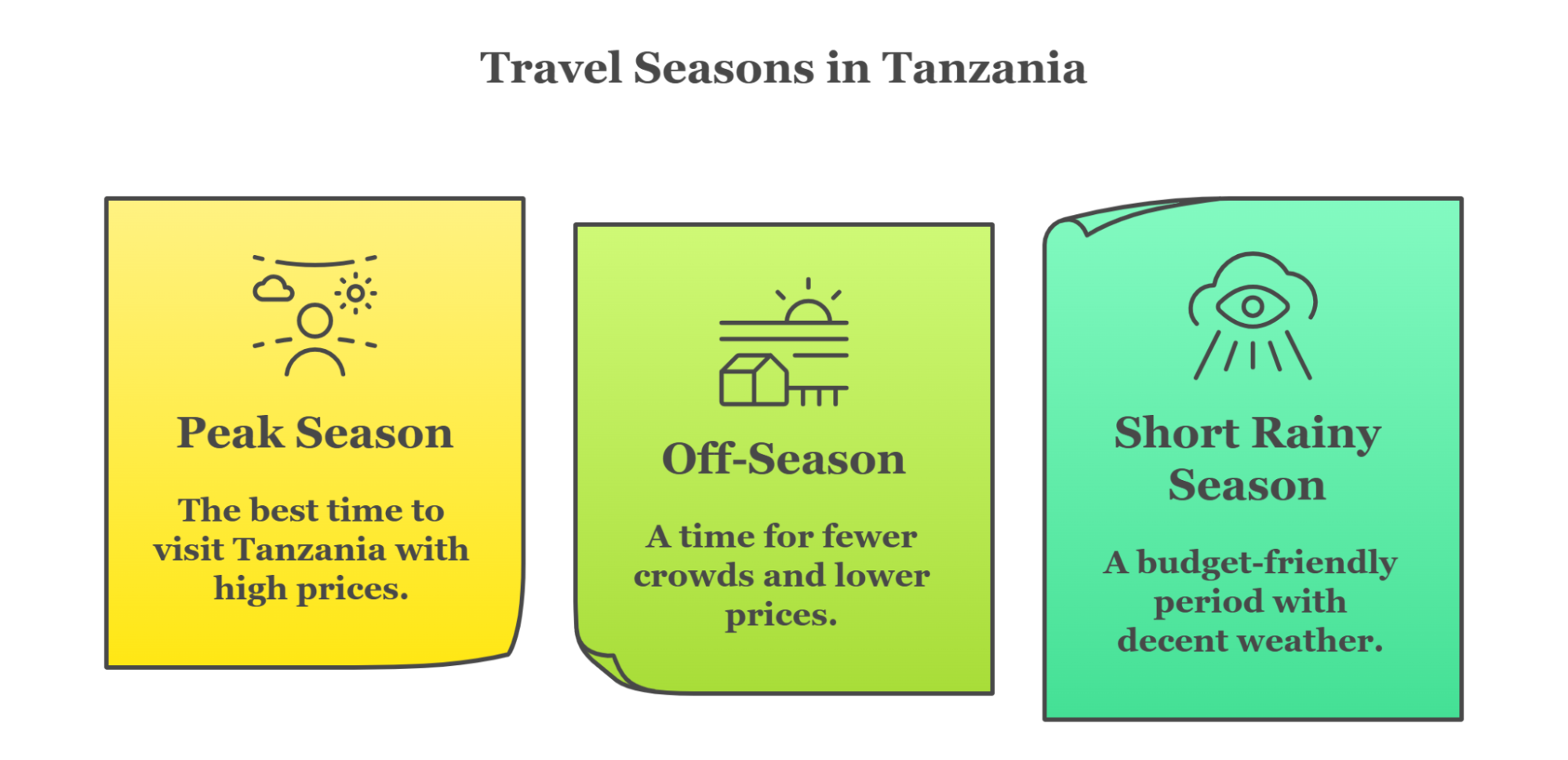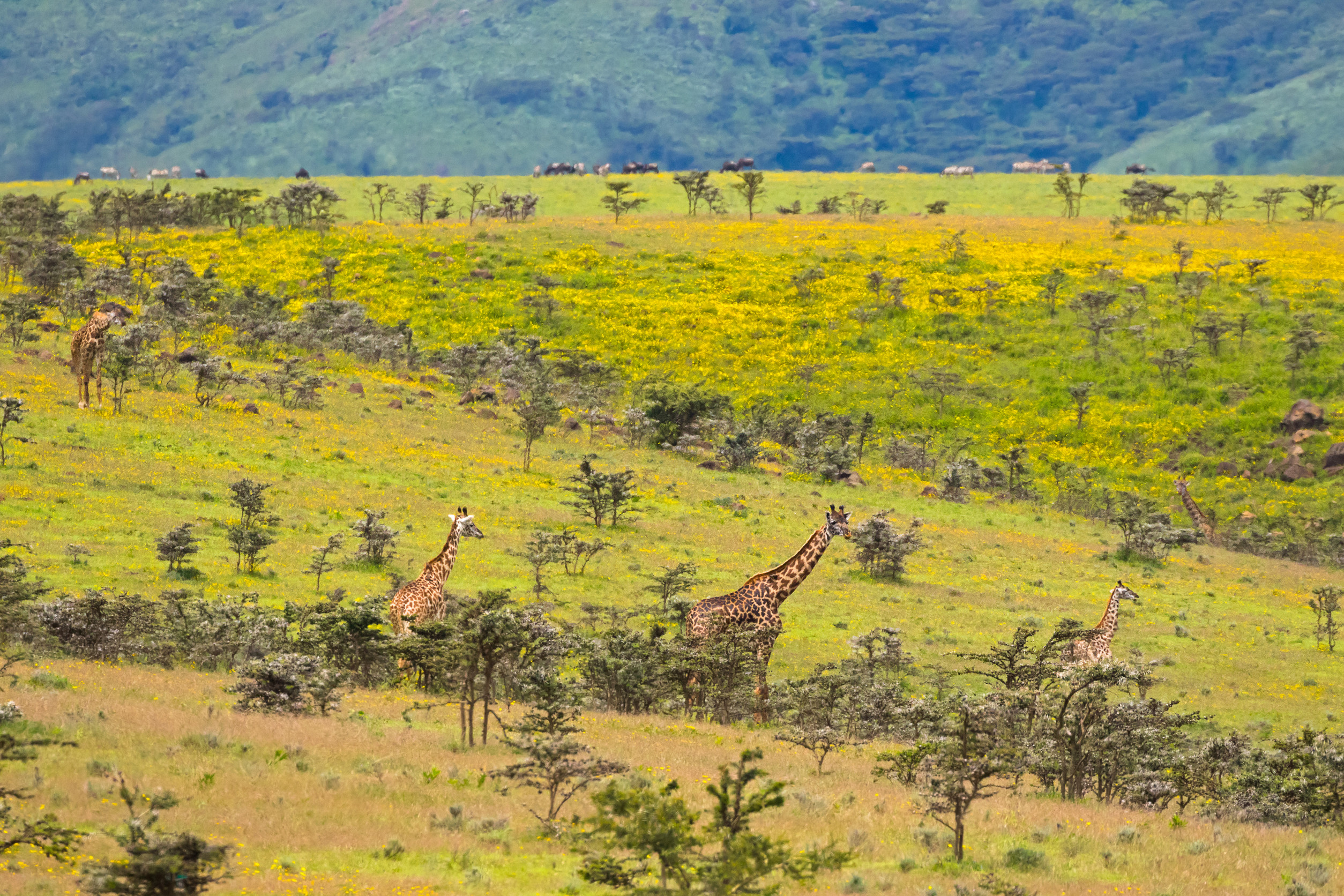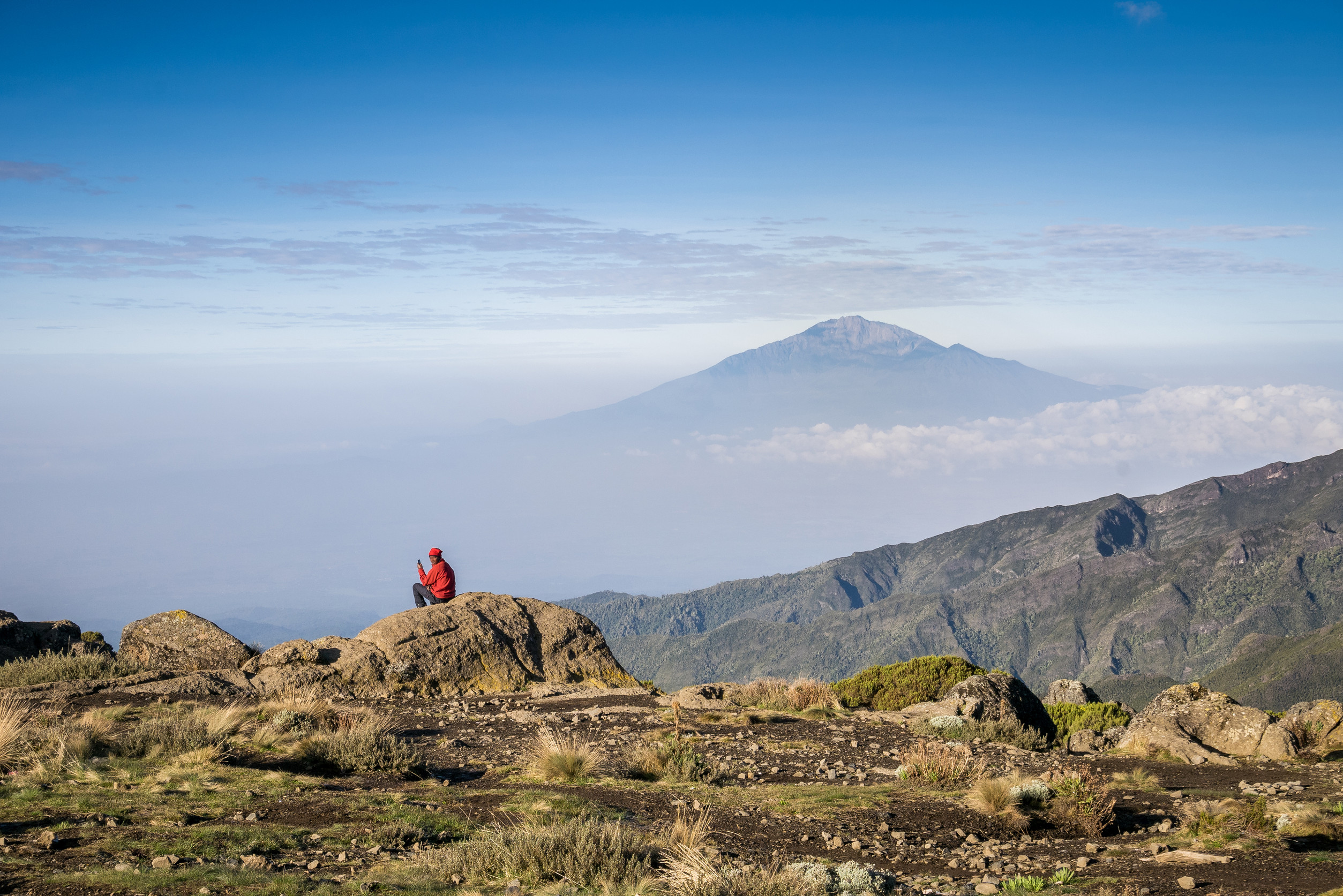Tanzania is the ultimate dream destination for most visitors, boasting spectacular landscapes, diverse wildlife, and cultural history. However, traveling to this East African country is expensive, especially for safaris and accommodations. Fortunately, there are several ways of exploring Tanzania on a limited budget without sacrificing the experience. For a budget-friendly trip to Tanzania, use local buses for transport, stay in guesthouses, and try street food for affordable dining. Book tours in groups and apply for your Tanzania eVisa early to save time and money.
Here are some key tips to make the most of your trip without breaking the bank.
1. Plan Your Trip During the Low Season
Tanzania’s peak travel season runs from June to October and during the Great Migration in the Serengeti. Prices for flights, accommodation, and tours skyrocket during this period. Traveling during the off-season (March to May) means fewer crowds and significantly lower prices for lodges, safaris, and flights. The short rainy season (November to mid-December) is another budget-friendly time with decent weather.

2. Choose Public Transport Over Private Transfers for Cost Savings
Private taxis and car rentals can be quite expensive in Tanzania, significantly increasing your travel costs. Instead, using public transport is a more budget-friendly alternative that allows you to experience the country like a local.
Local Transport Options
Local transport facilities in Tanzania provide affordable options compared to private hire taxis and cars. Dala-dalas (minibusses) are the most regular and affordable town and city transportation, but sometimes overcrowded. Bajaj (tuk-tuks) and bodaboda (motorbike taxis) are available for short-distance transportation and are less expensive than private hire taxis but have to be negotiated beforehand. In addition, shared taxis operate on fixed routes in most locations, offering a cheap and effective mode of transport while exposing travelers to local commuting culture.
Long-Distance Travel
For traveling between cities in Tanzania, several low-cost options are convenient and affordable. Bus services are a low-cost and safe mode of transport between major cities like Dar es Salaam, Arusha, and Mwanza. There are good companies such as Kilimanjaro Express, Dar Express, and Shabiby Line that have clean and comfortable buses, some of which are air-conditioned with reclining seats, making it a more convenient option than local minibusses but still very affordable compared to private transfers. Train travel is an alternative, with Tanzania's rail system covering Dar es Salaam to other destinations. This type of transport offers a cheap and picturesque ride, giving visitors the opportunity to view the country's scenery at their own pace.
3. Book Budget-Friendly Safaris
Safaris are the highlight of Tanzania but can be costly. Instead of luxury lodges, consider:
- Joining a group safari: Booking with a group significantly reduces costs compared to private tours.
- Camping safaris: Many tour companies offer camping safaris that are far cheaper than staying in lodges.
- Visiting lesser-known parks: The Serengeti and Ngorongoro Crater are expensive. Consider Tarangire, Ruaha, or Mikumi National Park, which offer incredible wildlife without the high costs.
4. Explore on Your Own in Some Areas

If safaris or guided tours are beyond your means, there are several options to explore Tanzania independently but still enjoy its beautiful landscapes and animals. Self-drive safaris are a good idea in parks like Mikumi and Ruaha, where good roads allow you to drive at your own pace. Renting a 4x4 vehicle offers you the freedom to plan your own schedule, stop for game viewing at will, and spare a considerable amount of money on guide and tour operator fees.
For a more personal experience, walking safaris in such areas as Arusha National Park allow you to walk through forests, observe giraffes and buffalo up close, and enjoy panoramic views of Mount Meru. Walking safaris not only cost less than automobile tours but also involve more immersion in nature.
Beyond the national parks, Tanzania's coastlines provide exciting potential for low-budget exploration. Bagamoyo and Pangani boast scenic beaches, historic sites, and Swahili culture, targeting independent travelers. Explore Bagamoyo's historic town center, visit the Kaole Ruins, or soak up the unspoiled Pangani beaches without a tour guide. To visit these places on your own entails greater flexibility and less expense at the expense of little adventure.
5. Choose Budget Accommodations
Tanzania has plenty of budget-friendly accommodation options:
- Hostels and guesthouses: Cities like Arusha, Dar es Salaam, and Zanzibar have affordable hostels and budget guesthouses.
- Camping: Many national parks and lodges offer camping options at a much lower cost than hotels.
- Airbnb and Couchsurfing: These options can help you find cheap stays while also offering a chance to connect with locals.
6. Eat Local Food

One of the best ways of saving money and experiencing Tanzania's lively food culture is to eat where the locals eat instead of at pricey tourist restaurants. Street food stalls and small eateries, known as "mama lishe," offer delicious and inexpensive meals that are both filling and authentic.
One of the must-try dishes is ugali with nyama choma, a staple dish of maize porridge served with grilled meat and commonly served with fresh vegetables or spicy sauces. Chapati and beans is another affordable and filling dish that provides a delicious combination of flatbread and flavorful beans. When in Zanzibar, do not miss Zanzibar mix, a unique and delicious soup made with fritters, potatoes, chickpeas, and coconut sauce that is a great combination of local spices.
For seafood lovers, local markets in Zanzibar are a great place to enjoy freshly caught fish, octopus, and prawns at a fraction of the price you’d pay in touristy restaurants. Whether grabbing a quick bite from a roadside vendor or enjoying a home-cooked meal in a small family-run eatery, eating local is a cost-effective and rewarding way to experience Tanzanian cuisine.
7. Use Local Tour Guides
Instead of booking tours with large international companies, hire local guides who offer budget-friendly options and a more authentic experience. Many local guides provide affordable walking tours in cities like Stone Town (Zanzibar) and Arusha, allowing you to explore history, culture, and hidden gems without overspending. In addition to being more economical, hiring local guides helps support small businesses and communities.
8. Negotiate Prices
Bargaining is a common practice in Tanzania, and it can help you save money on tours, souvenirs, transportation, and even accommodations. Vendors often start with higher prices, expecting customers to negotiate. Politely ask for a lower price, compare rates before making a purchase, and don’t hesitate to walk away if the price is too high—many sellers will call you back with a better deal. Negotiating is part of the experience and can make your trip more affordable while ensuring fair prices.
9. Avoid Extra Fees and Unnecessary Expenses
Saving money while traveling in Tanzania isn’t just about cutting big costs—it’s also about avoiding small but frequent expenses that can add up. By being mindful of fees and making smart choices, you can stretch your budget further.
- Withdraw cash wisely: ATMs charge high fees for foreign cards, so take out enough cash at once to minimize charges.
- Use a local SIM card: Buying a SIM card from Vodacom, Airtel, or Tigo is much cheaper than using international roaming, helping you save on data and calls.
- Bring a reusable water bottle: Instead of constantly buying bottled water, use a filtered bottle or refill where clean drinking water is available to cut costs and reduce plastic waste.
10. Explore Free or Low-Cost Attractions

Tanzania does not have to break the bank. There are plenty of low-cost or even free activities that enable you to experience the beauty and culture of the country without breaking the bank:
- Visit local markets:Dar es Salaam, Arusha, and Stone Town markets offer a vibrant cultural experience where you can shop for fresh fruits and vegetables, handmade souvenirs, and local delicacies.
- Summit Mount Meru: While Kilimanjaro is internationally famous, Mount Meru is a stunning and affordable hike at a tenth of the price.
- See waterfalls: Materuni Waterfalls near Moshi and Soni Falls near the Usambara Mountains are cheap to visit and have spectacular scenery.
- Relax on public beaches: Instead of paying to use private resorts, enjoy Zanzibar's stunning public beaches like Nungwi, Paje, and Jambiani where you can sunbathe and swim for free.
- Visit historical and cultural attractions: Certain heritage attractions, like Bagamoyo's Old Fort and Kaole Ruins, are cheap to enter and give a glimpse of Tanzania's history.
- Go to national museums: Museums such as the National Museum of Tanzania in Dar es Salaam or the Arusha Declaration Museum have informative exhibitions at a reasonable cost.
Summary
To explore Tanzania on a budget, use public transport like dala-dalas, opt for independent tours, and eat at local food stalls (mama lishe). Hire local guides, haggle prices, withdraw cash wisely, use a local SIM, and carry a refillable water bottle. Enjoy free or cheap activities such as markets, beaches, waterfalls, and cultural sites for an affordable adventure.